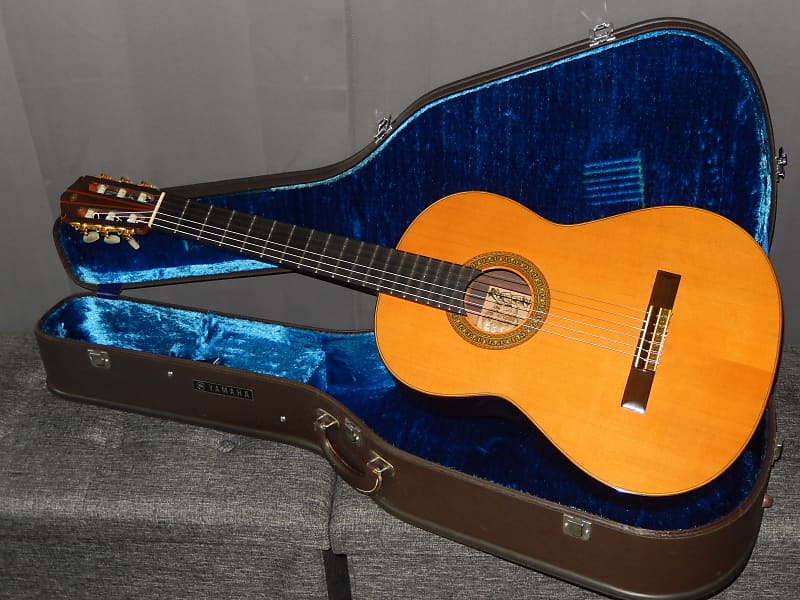

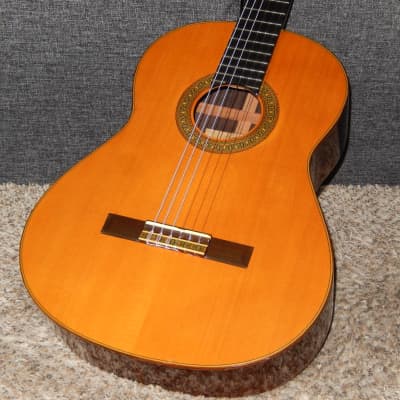
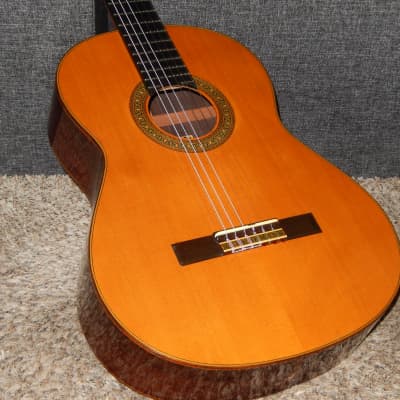
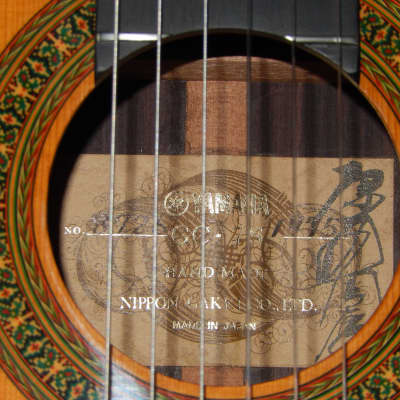
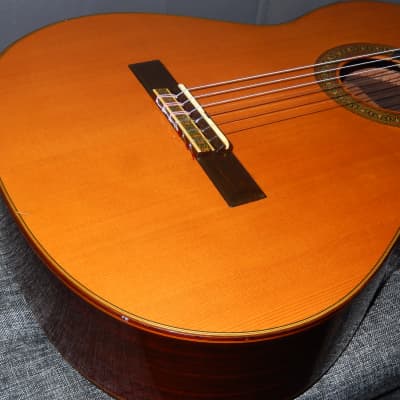
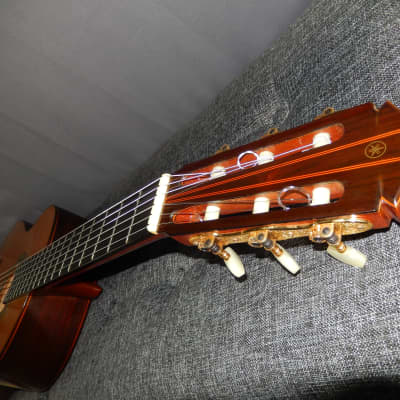
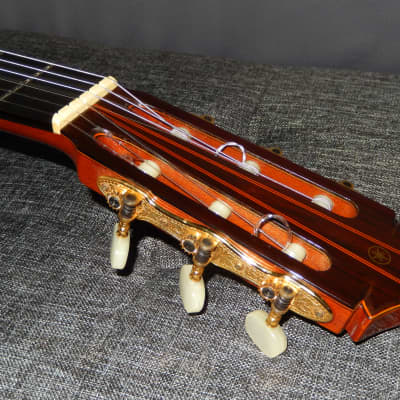
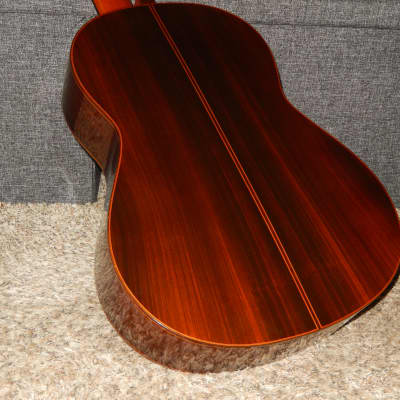
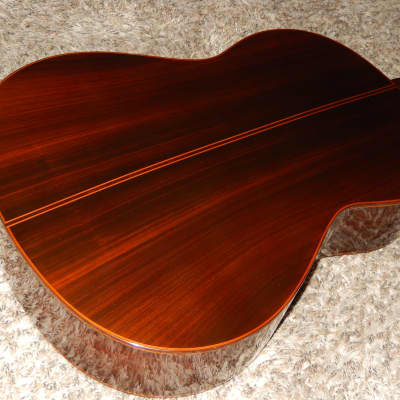
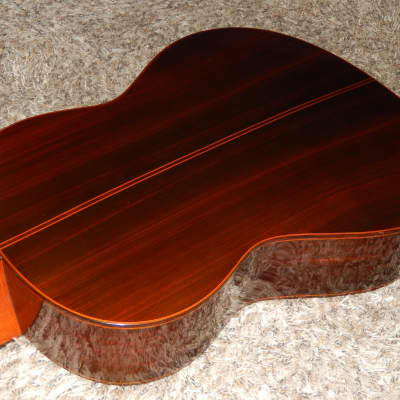
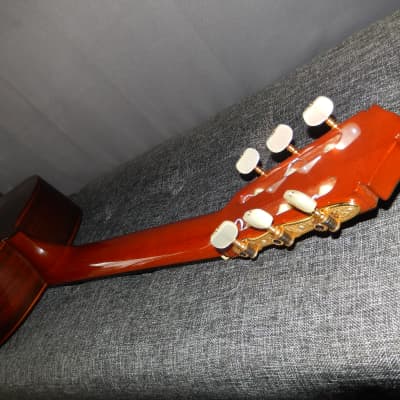
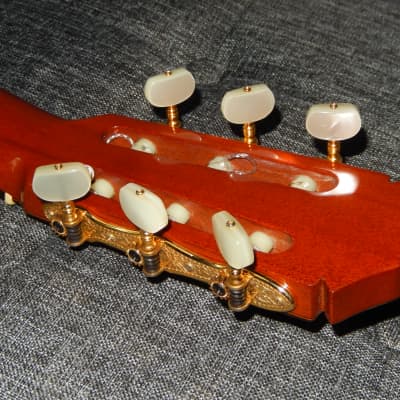
Several hundred guitars I have sold in the past are presented at Facebook.com/Victors.Guitar.Library.
Yamaha GRAND CONCERT GC7S 1975
This Yamaha guitar was made in 1975 by Hiroshi Harada, one of the best luthiers Yamaha Corporation ever had. Even though in 1975 it was the lower Grand Concert model within Yamaha’s classical guitar lineup, it certainly is a concert grade guitar.
Originally GC7S was made with solid Cedar top and solid Indian Rosewood back and sides. In 1979 its specification changed to laminated Indian Rosewood sides.
Yamaha GC7S being priced 70 000 yen in 1975, was not a cheap instrument at all. 10 000 yen was enough to get a decent beginner’s grade guitar in Japan.
Despite few very light marks on its body (with the sractch located at the bottom of the soundboard being the most noticeable one), can be described as “excellent for its age”. Excellent condition of the fingerboard and frets suggests that this guitar has been played very little over its lifetime.
This guitar is loud yet very romantic. Its trebles are super sweet yet also quite ringing. Basses are deep and full of overtones, yet relatively clean. All notes are well balanced, with great note clarity and separation, and with superb sustain.
It is certainly one of those guitars with “replacement value” much higher than its retail price at any given moment in time. It can easily compete with many brand new “hand made in Spain” classical guitars priced $3500+.
SPECIFICATIONS:
Year(s) Sold: 1974-1979
Top: Solid Cedar/lacquer
Back & Sides: Solid Indian Rosewood/urethane
Neck: Honduras Mahogany
Fingerboard: Ebony
String Length: 662 mm
Nut width: 52 mm
Guitar’s action is set to 3.70mm under E6 and 3.20 mm under E1 with still extra room on the saddle.
Guitar will be shipped in used original Yamaha hard shell case in still good condition.
IF YOU'D LIKE MUCH HIGHER CLASS INSTRUMENT AT SIMILAR PRICE YOU SHOULD CONSIDER Youhei Nishino No30 1982 and Yukio Nakade 30 1999 guitars were both priced 4 times higher than this Yamaha GC7S
YAMAHA CLASSICAL GUITAR HISTORY
Yamaha started their serious fight for international clients in 1967 with new lineup of classical Grand Concert guitars made according to Spanish blueprints. They were: GC3 (solid Spruce top/ solid Indian Rosewood b/s) GC5, GC7 and GC10 (all 3 models with solid Spruce tops and solid Brazilian Rosewood b/s).
In 1968 Yamaha also introduced their lineup of great Grand Concert flamenco guitars. They were GC5F, GC7F and GC10F. The master luthier responsible for production of these guitars was Toshihiro Kato. He was helped by Hiroshi Harada, who was making classical models GC3 and GC5. Both these luthiers were trained by Eduardo Ferrer, a Spanish luthier from Granada, Spain who being invited (and appropriately rewarded) by Yamaha co., travelled to Japan during years 1964-1967.
It is very important to explain that 1960s and 1970s were years of very rapid devaluation of Japanese yen (hence rapid inflation of prices for all products). Because during those years practically all guitar models had some numbers closely related to their prices in yen, these models were quite frequently upgraded (relabeled) to higher numbers reflecting their higher prices.
For that reason, mentioned above Yamaha’s classical GC guitars lineup, was changed in 1971. New (1971-1973) lineup included models GC3D, GC6D, GC8D, GC10D (all 4 models made with solid Spruce tops & solid Indian Rosewood b/s) GC12D, GC15D and GC20D (all 3 models with solid Spruce tops & solid Brazilian Rosewood b/s). It is worth to mention that until 1974 all Yamaha classical GC models were made exclusively with Spruce tops.
In 1974 Yamaha’s classical GC guitar lineup was changed yet again. In that year, for the first time in its history, Yamaha decided to make classical guitars with cedar tops. This newly introduced GC classical guitar lineup included models: GC5M(S), GC7M(S), GC10M(S), GC15M(S), (all with Indian Rosewood b/s), GC20M(S), GC30A, GC30B (all with Brazilian Rosewood b/s). M=spruce. S=cedar, A=spruce, B=cedar
Yamaha GC15S was priced 150 000 yen in 1975 just like Masaru Kohno model 15. Yamaha Co. didn't compete with Kohno by lowering prices of their guitars. Yamaha GC guitars simply offered more for the same price.
In 1975 Kohno top models were 15, 20 and 30 (all with Brazilian Rosewood b/s). Model 30 was priced 300 000 yen just like Yamaha GC30A(B). In 1977 Kohno changed his lineup adding models 40 and 50 (both with improved looks but sounding no different than his earlier model 30) and changing specifications of model 15 from Brazilian Rosewood b/s to Indian Rosewood b/s. Yamaha's kept their lineup unchanged until 1979. In order to keep their prices at the same level, Yamaha GC guitars made in 1979 were made with somewhat lower grade woods, different finishes and less impressive ornamental extras if compared with those made in 1974. Production of GCM and GCS models ended by the end of 1979. Between years 1980-1985, Yamaha's lineup was being changed at least few times.
In 1985 top models made at Yamaha's Hamamatsu workshop were GC70 (Spruce/figured Brazilian Rosewood, all shellac finish), GC60 (Spruce/figured Brazilian Rosewood, shellac finish top) GC50 (Spruce/figured Brazilian Rosewood, all lacquer finish) & GC40 (Spruce/figured Brazilian Rosewood, lacquer finish top), and GC30 (Spruce/straight grain Brazilian Rosewood, urethane finish).
Correct evaluation of a real grade of vintage Yamaha guitars can't be done just by looking at their model numbers. Yamaha GC10 from 1980 is simply no match with GC10M from 1975. Yamaha GC10D from 1973 is of equal grade with GC15M from 1975. Yamaha GC10 from 1970 is of equal grade with Yamaha GC20D from 1973 and GC40 from 1985.
Real Value of Japanese Vintage Guitars
The key to understand value of vintage Japanese guitars is to acknowledge galloping price inflation (devaluation of Japanese yen) during 1960s & 1970s. This inflation slowed down in 1980s.
During 1960s and most of 1970s model numbers of Japanese guitars were strictly interconnected with their prices in Japanese yen. By early 1980s and during following decades model numbers were no longer strictly associated with their prices. Some Japanese guitar makers introduced model names instead of model numbers. Others were still using model numbers with addition of letters and/or other symbols.
It is then important to understand that two Yamaha GC10 guitars made 10 years apart are two instruments of totally different class. The same applies to any other Japanese maker/brand.
The logical way to estimate the true class of any given Japanese made instrument is to compare its price with the average annual salary of wage workers in Japanese private sectors. This salary was: 450 600 yen in 1965 - 825 900 yen in 1970 - 1 868 300 yen in 1975 - 2 689 000 yen in 1980 - 3 163 000 yen in 1985 - 3 761 000 yen in 1990 - 4 107 000 yen in 1995 - 4 082 000 yen in 2000.
Any guitar priced 100 000 yen in 1970 (labelled as No10 or No100) would be priced 200 000 yen in 1975 (relabeled to No20, No200 or 2000), 300 000 yen in 1977 (labelled as No3, No30 or 3000) and 500 000 yen by 1985 (labelled as No50 or 5000).
Starting in 1977 Masaru Kohno introduced his new models No40 priced 400 000 yen and No50 priced 500 000 yen. By early 1980s Kohno started using model names instead of numbers and was steadily raising their prices without changing model labeling. His very top model 50 became model “Special”, and a decade later it became model “Maestro”. Naturally, all other Japanese guitar makers were doing similar pricing (labelling) upgrades.
Knowing all of that, you can bet on that Masaru Kohno No50 made in 1982 is practically the same grade instrument as Kohno No20 made in 1972, or Kohno no 30 made in 1975.
In early 1970s the lowest Ryoji Matsuoka (all plywood) model was 10, followed by (solid top) models 15, 20, 25, 30, 40, 50, 60, 80 and (all solid woods) models 100 and 150. Models 50, 60 and 80 were made with non-solid figured Brazilian Rosewood (double) back and sides and top model 150 was the only one made with solid figured Brazilian Rosewood b/s.
In 1980 the lowest Matsuoka model was (all plywood) 20, followed by (solid top) models 30,40,50, 60 and all solid woods models 80,100,150 and 200. By 1990 the lowest Matsuoka model was M40 and the highest was M300. By 2010 the lowest Matsuoka model was M50 and the top model was M270.
You can bet that Ryoji Matsuoka model 50 from 1980 is of the same grade as model M100 from 2000, model 100 from 1980 is of the same grade as model M150 from 2000, model 150 from 1980 is of the same grade as M200 from 2000 and model 200 from 1980 is of the same grade as model M300 from 2000.
It is important to mention that if modern era luthiers are using 40+ years old woods to make an “all solid” wood classical guitar, its price is minimum $8000.
All vintage guitars made with Brazilian Rosewood are especially precious, including those made straight grain varieties and those with non-solid b/s.
Because response and tonal properties of Spruce soundboards are improving over time, long seasoned Spruces are far more precious than long seasoned Cedars.
It is not very difficult to find out what are current prices of such guitars made by world’s leading luthiers.
Important message for Australian buyers:
USPS International Priority Mail packages destined for Australia have quite restricted size (max. length is 42” and max. length + girth is 97”). For these reasons I must use the case that is no longer than 41” and therefore it may be different than the one you see on the pictures. You should ask me for any other details prior to making a purchase.
Reverb Buyer Protection
Reverb has your back if your item is lost, damaged, or doesn't match its description. Simply report any issues within 7 days and we'll help you get a full refund.Learn more about Reverb Buyer Protection.
| Listed | 2 years ago |
| Condition | Excellent (Used) Excellent items are almost entirely free from blemishes and other visual defects and have been played or used with the utmost care.Learn more |
| Brand | |
| Model |
|
| Finish |
|
| Categories | |
| Year |
|
| Made In |
|
| Body Shape |
|
